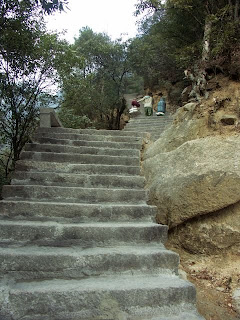To me, the climb up Huang Shan was just the perfect antidote to a month of living in a big polluted city in China. The clean air, lightly scented by the pine trees, combined with the greenery all around, made me feel like I was a million miles away from the pea soup I was breathing just a few days before. Despite the freezing temperature at night, I stayed at the top for two nights to explore the peaks on the network of stone trails.
 Located in eastern China, Huang Shan is only a little over five hundred kilometers from Shanghai.
Located in eastern China, Huang Shan is only a little over five hundred kilometers from Shanghai. Jagged peaks and misty clouds are features of Huang Shan.
Jagged peaks and misty clouds are features of Huang Shan. Climbing the concrete and stone steps is the ultimate Stairmaster. All the supplies at the top are carried up on bamboo poles on the shoulders of porters like this one. Tourists like me have the option of following their footsteps or going up in comfort in gondolas.
Climbing the concrete and stone steps is the ultimate Stairmaster. All the supplies at the top are carried up on bamboo poles on the shoulders of porters like this one. Tourists like me have the option of following their footsteps or going up in comfort in gondolas. The luxury hotel at the top caters to groups of well-heeled tourists. Penny-pinching backpackers can stay at the unheated but much cheaper guesthouse across the plaza. There’s no question which one I picked.
The luxury hotel at the top caters to groups of well-heeled tourists. Penny-pinching backpackers can stay at the unheated but much cheaper guesthouse across the plaza. There’s no question which one I picked. The view across the peaks into the sea of clouds, just a five-minute walk from the guesthouse.
The view across the peaks into the sea of clouds, just a five-minute walk from the guesthouse. As evening approached, more clouds started to roll in to envelope the whole mountain.
As evening approached, more clouds started to roll in to envelope the whole mountain. The next morning, I woke up to find the whole place shrouded in dense fog. Well, bad timing on my part. I walked around anyway, finding steps carved into rocks in places where the fog thinned out enough to see more than a few meters in front of me.
The next morning, I woke up to find the whole place shrouded in dense fog. Well, bad timing on my part. I walked around anyway, finding steps carved into rocks in places where the fog thinned out enough to see more than a few meters in front of me. At a place where I could barely see five meters away, I came upon a rock where the water dripping down was the only sound around. Click, click, click.
At a place where I could barely see five meters away, I came upon a rock where the water dripping down was the only sound around. Click, click, click. Dried leaves clinging on to the branches in the winter cold
Dried leaves clinging on to the branches in the winter cold This little creek near the guesthouse was frozen in place.
This little creek near the guesthouse was frozen in place. As the evening approached, the gnarled and twisting pine shrouded in dense fog added an eerie quality to the place.
As the evening approached, the gnarled and twisting pine shrouded in dense fog added an eerie quality to the place. The third morning, the fog receded, but mother nature didn’t give me one of the sunrises this mountain is famous for.
The third morning, the fog receded, but mother nature didn’t give me one of the sunrises this mountain is famous for. Walkways like this built into sheer cliffs allow people to see the Grand Canyon of Huang Shan.
Walkways like this built into sheer cliffs allow people to see the Grand Canyon of Huang Shan. View from one of the walkways over the “West Sea.”
View from one of the walkways over the “West Sea.” These almost-vertical trails are not for the faint of hearts.
These almost-vertical trails are not for the faint of hearts. Taking a break, these sedan carriers had been desensitized to the breathtaking scenery around them.
Taking a break, these sedan carriers had been desensitized to the breathtaking scenery around them. Travel in style – being carried around in a sedan on a mountain
Travel in style – being carried around in a sedan on a mountain The "Welcome Pine", the symbol of Huang Shan, is probably as famous to the Chinese as the General Grant sequoia tree is to Americans.
The "Welcome Pine", the symbol of Huang Shan, is probably as famous to the Chinese as the General Grant sequoia tree is to Americans. It’s difficult to go straight down while trying not to lose your footing by getting distracted by the scenery.
It’s difficult to go straight down while trying not to lose your footing by getting distracted by the scenery. Everywhere you turn, there are pine trees taking a foothold on craggy rocks like this one.
Everywhere you turn, there are pine trees taking a foothold on craggy rocks like this one.
No comments:
Post a Comment